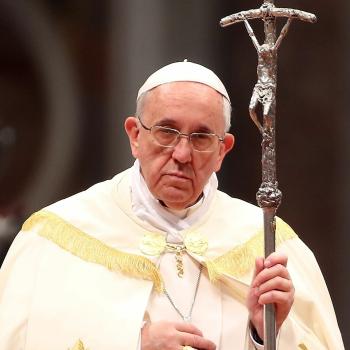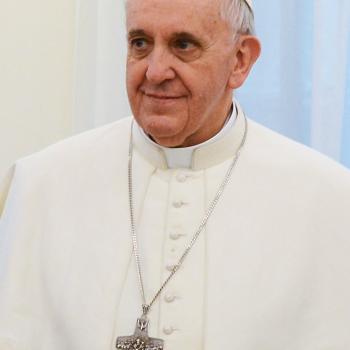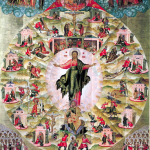Charlie Brown: I guess you were right, Linus. I shouldn’t have picked this little tree. Everything I do turns into a disaster. I guess I really don’t know what Christmas is all about.
[shouting in desperation]
Charlie Brown: Isn’t there anyone who knows what Christmas is all about?
Linus: Sure, Charlie Brown, I can tell you what Christmas is all about.
[moves toward the center of the stage]
Linus: Lights, please.
[a spotlight shines on Linus]
Linus: “And there were in the same country shepherds abiding in the field, keeping watch over their flock by night. And lo, the angel of the Lord came upon them, and the glory of the Lord shone round about them: and they were sore afraid. And the angel said unto them, ‘Fear not: for behold, I bring unto you good tidings of great joy, which shall be to all people. For unto you is born this day in the City of David a Savior, which is Christ the Lord. And this shall be a sign unto you; Ye shall find the babe wrapped in swaddling clothes, lying in a manger.’ And suddenly there was with the angel a multitude of the heavenly host, praising God, and saying, ‘Glory to God in the highest, and on earth peace, good will toward men.'”
[Linus picks up his blanket and walks back towards Charlie Brown]
Linus: That’s what Christmas is all about, Charlie Brown.
In forty-seven years of continuous broadcasting, what is not to love about Charles Schulz’s Christmas classic, “A Charlie Brown Christmas”? It is a colorful, yet grainy world of raspy-voiced children (and an uncommonly enterprising dog) shifting scenes from a snowy Christmas tree farm to an unsupervised school auditorium. These precocious children wrestle with thinly veiled adult issues ranging from excess commercialism to seasonal depression. How could this be anything but a success? That was hardly the question being asked by cartoonist Charles Schulz, producer-director Lee Mendelson, and Warner Bros. animator Bill Melendez as they quickly assembled and presented their work in rapid succession to an animators’ focus group, Coca-Cola’s (the sponsoring corporation) advertising executive, and, finally, CBS executives. Whether it was the misspelled cartoonist’s name in the credits, the quirky children characters’ pace and interactions, or the need for a rushed ten-minute composition of words for a particular ice-skating melody, the future of the Christmas special (if not the whole 15 year-old Peanuts cartoon enterprise) was seriously in doubt.
But what really stands out in the story of “A Charlie Brown Christmas”, beyond the ragtag last-minute editing shenanigans, was the overtly and unashamed religious quality of the program. In the throes of one of the most turbulent modern decades, a little boy with a blanket recites, under spotlight, Luke 2:8-14 9 (see above). It is the pinnacle of the show. It is the purpose of the show. Commercialism, seasonal depression, a malaise over the purpose of Christmas (if not the purpose of life) is all answered in the grainy voice of Linus. And this is done, without creating an undue heaviness or pomposity ill-fitting of a cartoon. A brilliant balance was struck. But this does not seem surprising, for Charles Schulz had been doing this for fifteen years in his daily comic strip. Washington Post reporter Michael Cavna, in his wonderful article about the evolution of “A Charlie Brown Christmas” (cited below), characterizes Schulz as being very clear about the goal:
Charles Schulz insisted on one core purpose: “A Charlie Brown Christmas” had to be about something. Namely, the true meaning of Christmas. Otherwise, Schulz said, “Why bother doing it?”
And when the issue regarding the overt use of Biblical text in the story was raised by Mendelson and Melendez, Schulz frankly responded:
“If we don’t do it, who will?”
On December 9, 1965, half of American households tuned into the debut of “A Charlie Brown Christmas”. It was an unmitigated success. Winning numerous industry awards and spawning manifold future specials, “A Charlie Brown Christmas'” greatest legacy rests in the hearts of its viewers. Regular folk (like me) are moved by Charlie Brown, the eternal underdog. And this is because there is a little bit of Charlie Brown in each one of us. Charlie Brown who grapples with the fears and insecurities, the questions and the concerns that reside deep inside us all because we fear we are alone in worrying the way we do. Linus, the thumb-sucking ‘old soul’ gently and innocently leads Charlie Brown (and us) to the answer the age neglects. What is Christmas all about, he asks? What, effectively, is life all about? A babe lying in a manger with a host of angels proclaiming the appearance of God on earth, and the beginning of man’s long-awaited reconciliation with God and his fellow-man. THAT, Linus says to Charlie Brown and us, is what it is all about. Yes, that is what it is all about. Perhaps it is important for us to hold that Truth a little more closely, and pass it on a little more easily, not simply during the Christmas season, but all the year-long. To echo Charles Schulz, “If we don’t do it, who will?”
Please read Michael Cavna’s excellent piece:
‘A CHARLIE BROWN CHRISTMAS’: The gospel truth behind how a humble ‘Peanuts’ holiday classic defied the odds (12/5/11 – Washington Post)
(http://www.washingtonpost.com/blogs/comic-riffs/post/a-charlie-brown-christmas-the-gospel-truth-behind-how-a-humble-peanuts-holiday-classic-defied-the-odds/2011/12/02/gIQA0NNPWO_blog.html)
And please feel free to follow me on twitter @thinkercatholic















